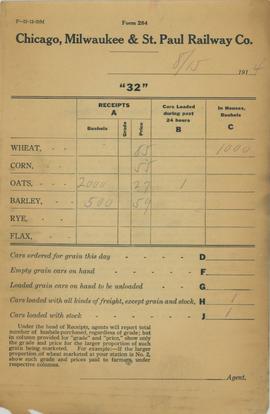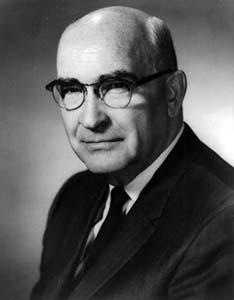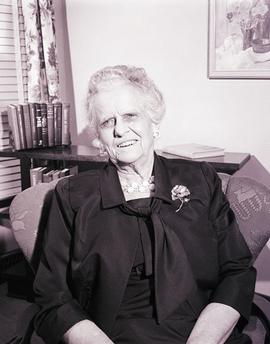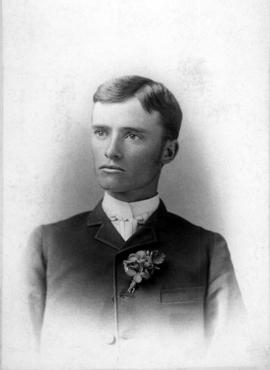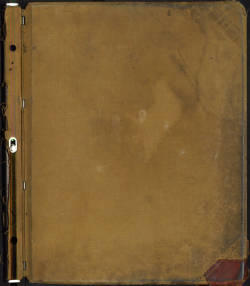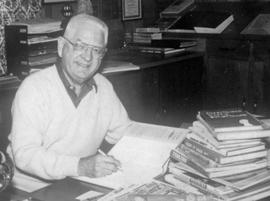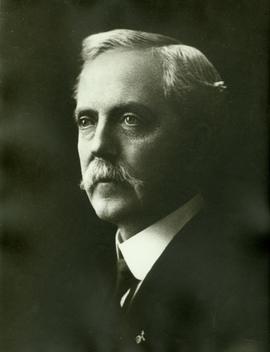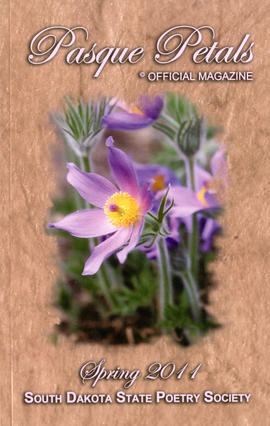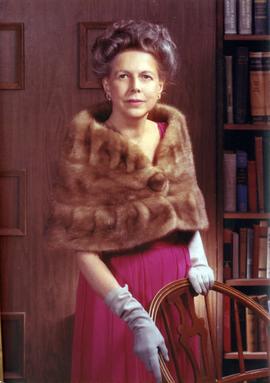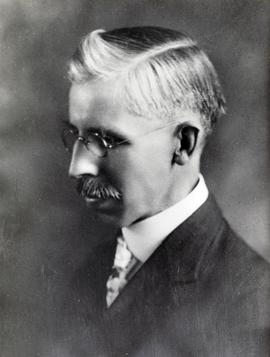The Ben Reifel Papers document the career of Ben Reifel, the first Lakota Sioux to serve in the U.S. Congress, highlighting his work as a legislator, his tenure with the Bureau of Indian Affairs, and his advocacy for Native American communities. The collection includes correspondence, photographs, audiovisual materials, memorabilia, and scrapbooks that provide insight into his contributions to public service and Native American affairs. As a pioneering Native American leader, Reifel played a key role in shaping policies related to education, healthcare, and economic development. This collection serves as a valuable resource for understanding his lasting impact on indigenous representation in government and South Dakota’s political landscape.
The activities series contains records of Reifel's involvement with various organizations and initiatives, including the Boy Scouts of America, the National Park Service, and the Dakota Territory Citizen Certificates project. It also covers his efforts in Native American affairs, congressional trips, and public events. The awards and honors section features certificates, plaques, medals, and other recognitions Reifel received throughout his career, including awards from the Boy Scouts of America, Sioux tribes, and South Dakota State University.
The Bureau of Indian Affairs materials include correspondence, newsletters, and newspaper clippings that document Reifel’s work in advancing Native American education, healthcare, and policy. The campaign series provides an in-depth look at his political career through financial records, advertisements, schedules, and materials related to the South Dakota Republican Party platforms.
Correspondence within the collection spans from Reifel’s tenure with the BIA through his congressional career, featuring letters exchanged with prominent political figures such as Barry Goldwater, Lyndon B. Johnson, Richard Nixon, and George McGovern. The family history section contains biographical materials, educational records, military service documents, and personal writings that provide insight into his early life and career development.
Memorabilia in the collection includes campaign materials, presidential inauguration items, and personal artifacts such as a U.S. Annotated Code book with Reifel’s name embossed on the cover. The photographs offer a visual record of his political career, community interactions, travels, and personal life, particularly highlighting his work in Congress and his connections with Native American communities.
The audiovisual materials consist of campaign advertisements, legislative discussions, interviews, and speeches on healthcare, agriculture, and public service. These recordings also include public appearances and fundraising events. Scrapbooks primarily contain newspaper clippings and campaign materials that document Reifel’s public image and key political milestones.
Collected materials include books, periodicals, programs, and poetry reflecting Reifel’s diverse interests and professional pursuits. His speeches and writings consist of transcripts and drafts of addresses given at events such as Memorial Day ceremonies and commencement exercises.
Overall, the Ben Reifel Collection provides a comprehensive view of his contributions to public service, Native American advocacy, and South Dakota’s civic and political landscape. It serves as a valuable resource for researchers seeking to understand his legislative impact, community engagement, and personal legacy.
This collection originated from the Madison, S.D. Railway Depot and was then donated to Prairie Village of Madison. The barn in which Prairie Village kept the records burned down but the records were salvaged. The collection provides a variety of different communications and report information, and is an excellent source to view original documentation. However, the collection is not a complete record of all communications and so is not an effective source for researching specific transactions, etc. It is organized into folders each containing a different form of communication used by the railroad company. The beginning of the collection contains all photocopied material. The middle of the collection contains the encapsulated material, and the end of the collection contains the samples of original records.
Because this collection was damaged in a fire all records received were photocopied with only a few original samples retained from each category of the collection. Some unique samples were encapsulated for easier handling and display.
Chicago, Milwaukee, and St. Paul Railway CompanyThe collection consists of materials relating to his work with research and production of small grains such as wheat, oats, and flax, and in particular the development of Hope Wheat. In addition, the collection contains biographical information about McFadden and his writings and speeches.
McFadden, Edgar S. (Edgar Sharp), 1891-1956The Frank E. Denholm Papers consist mostly of materials generated during the time he served as the representative to South Dakota’s First Congressional District, from 1971 to 1975. These materials document his work for rural America, particularly his effort to reinstate the Rural Electrification Act and numerous legislation regarding agriculture, rural water, and rural development. Press releases and newspaper clippings about his activities in Congress can be found in the papers. The collection also includes scrapbooks and memorabilia about his campaigns for Congress. In addition, there are several files of correspondence, some of which was with members of Congress and other notable people such as George McGovern and Richard Kneip. The collection includes nearly 1,500 photographs and slides, most of which relate to his campaigns for Congress. There are reel-to-reel audio recordings and video recordings on 2-inch quad video tape that consist of campaign advertisements and his work in Congress. The collection also documents Denholm’s career as a sheriff, auctioneer, F.B.I. agent, and lawyer.
The papers also contain documents relating to Frank Denholm’s wife, Mildred Niehaus Denholm. Mrs. Denholm was born May 9, 1927 to Frank F. and Elizabeth C. (Schuring) Niehaus from Andover, South Dakota. She married Frank Denholm on June 12, 1950 in Webster, South Dakota. She attended Northern State Teachers College in Aberdeen, SD and taught in rural schools. Mrs. Denholm also went to the Aberdeen School of Business, the Strayer Business College in Washington, D.C., and the University of Utah where she studied music. She worked as a medical and legal secretary. Mrs. Denholm actively campaigned for her husband. She was involved in the Congressional Women’s Club while Denholm was in office. Mrs. Denholm passed away August 14, 2014. The collection includes correspondence between Frank and Mildred Denholm and her activities with the Congressional Women’s Club.
This collection contains a variety of materials documenting historical, personal, and professional narratives. It includes biographical sketches, photographs, clippings, collected scripts, writings spanning several decades, and an M.S. thesis. A significant portion is dedicated to a World War II trip, featuring correspondence, diaries, interviews, maps, speeches, research notes, and collected materials. Other highlights include tributes, miscellaneous items, and materials related to agriculture and economic studies. The collection offers a comprehensive view of various topics and periods, emphasizing key historical events and personal experiences.
Biggar, George C. (George Cecil) 1899-1989The collection includes clippings (1960–1965), correspondence (1929–1962), and materials from the Department of History and Political Science (1943–1957). It features Glimpses of SDSU (1957), A History: The Abbots, the Allyn’s, the Stickney’s and the Young’s (undated), greeting cards (undated), and a Study in History (undated). It also contains manuscripts by Gertrude Stickney Young, including material on the history of South Dakota State University's history department, Christmas cards with artwork by Ada Caldwell, certificates, and other personal items.
This collection offers valuable insights into Young’s academic and civic contributions, reflecting her influence on South Dakota State University and her dedication to preserving history. Works such as Glimpses of SDSU and family histories underscore her role as a writer and historian, while correspondence and clippings highlight her professional and personal impact. The collection is a significant resource for understanding South Dakota's educational and cultural development.
Young, Gertrude Stickney. 1883-1965This collection is composed of the personal papers of Hilton M. Briggs. It is composed of material related to his retirement as president of South Dakota State University and his life after his retirement. It also contains recognition materials in the form of plaques, certificates, and trophies. Included are many files related to his induction to the Saddle and Sirloin Club portrait collection. Also included are biographical materials, clippings, correspondence, writings, photographs, and scrapbooks.
Briggs, Hilton M. (Hilton Marshall), 1913-2001This collection is composed of three diaries of J.M Aldrich during his tenure as a student at Dakota Agricultural College from 1885-1888. The diaries give an invaluable account on life as a student during the early years of the college.
The diaries are separated into three volumes, one for each year Aldrich was a student at the college. Between 1930 and 1932, Aldrich made typewritten transcripts copied from his original diaries and included parenthetical comments for clarification. Each daily entry states the day and date, which are underlined, and relate Aldrich's daily activities. Most of the entries are trivial, recounting the activity of each day, but give an excellent portrayal of the atmosphere of Dakota Territory life in the 1880's. Topics included in the diaries range from accounts of his journeys between his home in Minnesota to Brookings to administrative upsets such as President George Lilley losing his position to Lewis McLouth.
Aldrich, John Merton, 1866-1934The John E. Miller papers are composed of materials collected by Dr. Miller during his career. Included is course material, interviews, talks, writings, Laura Ingalls Wilder, and friends and colleagues. The bulk of the material is Laura Ingalls Wilder and research for his many other writings.
GENERAL MATERIAL
The general material consists of files related to Dr. Miller’s personal life outside of teaching and writing. He was involved with many organizations, such as the South Dakota Humanities Council, the South Dakota State Historical Society, Phi Kappa Phi, and history conferences, such as the Midwestern History Association and the Dakota History Conference. Included are correspondence, photographs, awards, articles about Miller, SDSU material, and family files.
COURSE MATERIALS.
Dr. Miller taught many courses during his tenure as a faculty member of the History Department at South Dakota State University. Courses include U.S. History, South Dakota history, American economic history, and methods and philosophy of history. After his retirement he taught Osher Lifetime Learning Institute [OLLI] courses on many topics such as the great depression, U.S. president and legislators, and democracy. Included are course notes, exams, and other material related to teaching history.
FRIENDS AND COLLEAGUES
This material is composed of material gathered on friends and colleagues. Included is correspondence, articles, clippings, and photographs.
INTERVIEWS.
Dr. Miller conducted many oral history interviews during the course of his career. The recordings include many important historical figures, such as George McGovern and John Wooden, as well as prominent members of the South Dakota State University community, and SDSU faculty, staff, and administrators. His early interviews were recorded on audiocassettes, and eventually upgraded to digital recorders. There are some transcripts and permission forms for these recordings, but not all.
See the audiovisual and electronic media series for the recordings.
TALKS, PRESENTATIONS, ETC.
This series consists of many talks, presentations, and workshops given by Dr. Miller throughout his career. He also served on panels at conferences, including the Dakota History Conference and Laurapalooza. Included are notes used articles, journals, books, and research material.
LAURA INGALLS WILDER
Dr. Miller is one of America's leading authorities on Laura Ingalls Wilder and Rose Wilder Lane, having written many books and articles on the Wilder’s. Material consists of 16 boxes of research on books written by Laura Ingalls Wilder and her daughter, Rose Wilder Lane, the Ingalls-Wilder family, places where Wilder lived, notebooks of handwritten notes, critiques of other authors works on Wilder, articles and clippings on related to Wilder, research gathered from manuscript collections related to Wilder, other authors works, and Dr. Miller’s writings.
WRITINGS
Dr. Miller wrote many articles, books, and reviews during his career. He also wrote book chapters, collaborated with other authors, and encyclopedia entries. He was a very prolific writer and it is difficult to know whether everything he ever wrote is included in the collection. Included are manuscripts, books, articles, book proposals, notes, and correspondence with other authors and publishers.
RESEARCH
The research material is composed of material collected by Dr. Miller for various projects. Researchers will find material on topics such as politics, elections, democracy, U.S. and South Dakota history, sports, small towns, and creativity; and historical figures such as Johnny Carson, Lawrence Welk, Sam Walton, John Wooden, Walt Disney, George McGovern, Karl Mundt, Alvin Hanson and many others too numerous to list. This material was used in his writings and in teaching his courses at SDSU.
Included are 40 boxes of articles and clippings from newspapers, magazines, scholarly journals, books, and online research gathered during his many trips to archives, historical societies and libraries. The material consists of notebooks and handwritten notes, writings, publications, books, and photographs. The majority of the material is photocopies, but some books, magazines, and journals are also included.
The Brookings County research is composed of research gathered by John E. Miller from the Donald D. Parker Collection held at the Center for Western Studies, Augustana College, in Sioux Falls, South Dakota. Donald D. Parker was Head of the History Department at South Dakota State University from 1943-1965. Folders consist mainly of research on early Brookings County, South Dakota and covers the years from circa 1870-1930.
The Hubert B. Mathews and Hubert Jean Mathieu Hubert B. Mathews attended Dakota Agricultural College in Brookings in 1888 and accepted a position on the college staff in 1893. He became head of the physics Department, and was the first acting dean of the Division of Engineering. He was Vice President at South Dakota State College. H.B. Mathews coordinated much of the building work on the campus during the first half of the 20th century. Mathews Hall, a dormitory on campus, is named in his honor. Professor Mathews served twice as the Mayor of Brookings from 1907-1910 and again from 1915-1917. Hubert Jean Mathieu, son of Hubert B. Mathews, graduated from South Dakota State College in 1919. He then studied painting under Harvey Dunn. He is known for his Our Democracy editorial cartoons that appeared in such magazines as the Saturday Evening Post, Colliers, Ladies Home Journal, McCall’s and Cosmopolitan in the 1940s. He changed the spelling of the family name back to the original French spelling of Mathieu, supposedly for art reasons. He used the name "Mat" as his signature on many of his works.
Because of their relationship as father and son and their similar names, researchers should look at each folder carefully to ensure the correct information is gathered as material for both men is interfiled. Included are drawing of the campus of South Dakota State University by Hubert J. Mathieu as well as several of the Our Democracy editorial cartoons. The notes file was compiled by Dr. Miller and includes a notebook and several homemade note cards. The photograph file consists only of one photocopied page of three photographs of both Hubert B. and Hubert J.
The Brookings County Democratic Party records are composed of material given to John E. Miller by Ruby Mershon. Her father, Paul, was county chairman of the Brookings Democratic Party during the 1950s. Folders contain clippings, campaign material, newsletters, financial material, programs, and sample ballots. Some items of note include an official program and souvenir banner commemorating the visit of President John F. Kennedy to St. Cloud, Minnesota in 1962.
The South Dakota State University: A pictorial history, 1881-2006 research consists mainly of photocopies of clippings, articles, and yearbooks etc. Researchers will find material related to all areas of the history of South Dakota State University, from activities, athletics and administration to buildings, Hobo Day, and alumni, students and faculty.
The Looking for History of Highway 14 series is composed of research gathered by John E. Miller for this book. The book highlights fifteen towns and Mount Rushmore National Memorial. Folders consist of research gathered while compiling chapters for this book and include newspapers, county history books, photographs, and notes by Miller.
AUDIOVISUAL AND ELECTRONIC MEDIA
This series consists of 231 audiocassettes, 10 digital recorders, 17 CDs, 1 DVD, 18 USB flash drives, 24 SD Cards as well as some born digital material.
The collection is composed of manuscripts, correspondence, galley proofs, research, books and publications related to her published works of fiction and nonfiction.
The general material is composed of Norris' juvenilia from Bennington College, instructors' mid-term and final reports of her course work from college, and biographies and interviews of Norris conducted by various media organizations. Also included is a collection of notebooks from the early 1970's to 2009. These notebooks are spiral bound and appear to be daily journals with notes and drafts of poems and essays. They also contain postcards, clippings, business cards, prayer cards, photographs, recipes, etc. Of note is the manuscript for “Elizabeth Kray’s Letters, Memos, and Notes to Marie Bullock: Two Great Ladies of American Poetry”. A 1937 edition of “Conversation at Midnight” by Edna St. Vincent Millay and signed by John H. Norris is also included.
Poetry is composed of Norris' poetry in anthologies, books, catalogs, chapbooks, contributions, and periodicals. These publications all include Norris' poetry, and some also include works by her husband, David Dwyer, (this will be noted on the front of the folder).
Nonfiction books consist of draft and annotated manuscript pages, galley proofs, cover art and typeface layout, book jackets, book notes, correspondence, research, reviews, audio books, international editions, promotional material, book tour information, advance proofs, hard cover and paperback books. Material varies with each book title. This material is arranged alphabetically by publication title.
Other writings consist mainly of essays, reviews, and sermons published in journals, anthologies, books, textbooks, etc. Also included are scripture reflections for daily devotions, Afterword’s, Forewords, Introductions, Prefaces, and Symposia to which Norris has contributed.
Works mentioning Norris are also included. They are composed of publications with articles mention Kathleen Norris.
This collection is composed of materials related to dance and the teaching of dance at South Dakota State University. Slides, photographs, videos, posters and scrapbooks document the formal entrance of dance into the university curriculum.
The awards and plaques are composed of various awards and plaques presented to Marilyn Richardson over the years.
The general papers is composed of programs, newsletters, Dance Club material, dance camp and workshop material, concert choreography, and clippings from newspapers and other publications. Also included is the Dance Minor proposal and history at SDSU, information on Nellie G. Kendall, Barbara Kohn, and Terry Larvie, and biographical data of Marilyn Richardson.
The publicity material is composed of posters used for publicity for dance concerts given at SDSU by students, faculty and guest artists and companies. Some of the posters include collages of photographs which may duplicate photographs in the Photographs, Slides and Videocassettes series.
The photographs, slides and video cassettes include images of students and faculty, dance concerts, rehearsals, camps, workshops, the Motion Machine and guest artist and companies. The videos are of concerts, the Motion Machine, student projects, student solos, dance camps, rehearsals, and experimental dance.
The scrapbooks were created for the Dance Club and the Modern Dance Club and include photographs, programs, and clippings.
Richardson, Marilyn (Marilyn W.)The N.E. Hansen papers represent a comprehensive archive chronicling the career of Niels Ebbesen Hansen. The collection encompasses a diverse range of materials, including authored articles, bulletins, and circulars from Hansen's tenure at the South Dakota Experiment Station, as well as field notebooks, and ledgers from the South Dakota Horticultural Society.
Contributions from Helen Hansen Loen, Hansen's granddaughter, further enrich the collection with addresses, correspondence, journals, and travel documents, offering a deeper understanding of his professional and personal life. Notable highlights include addresses delivered by Hansen at prestigious events like the International Congress of Genetics in Berlin, underscoring his scholarly impact.
The collection's breadth extends to reports on forestry, sheep, and forage crops, reflecting Hansen's diverse interests. Manuscripts delve into topics ranging from agricultural practices to fine arts, while photographs document Hansen's expeditions to Siberia and Northern China, providing visual context to his exploratory work. Of particular significance are Hansen's manuscripts examining Soviet Russia's socio-political and economic landscape from 1934 to 1937. These writings offer valuable insights into agricultural collectivization, industrialization, and societal dynamics during that period, complementing Hansen's broader contributions to agricultural science.
Hansen, N.E. (Niels Ebbesen), 1866-1950The book contains 146 plats detailing property boundaries and ownership and leasing of lands on the Pine Ridge Reservation dating between 1936 and 2005. Changes to the plats are recorded on transparency sheets that are placed on top of the original pages. In order to provide as much detail as possible, the digitized copy of the original contains three scanned images for each plat: the transparency sheet and the original sheet, the transparency sheet alone, and the original sheet alone.
The beginning of the book includes a page describing the color code for the shading found within the pages of the book. The shading represents status of the land. Much of this page is faded and difficult to read.
The next page of the book is a typewritten copy of the "Order of Restoration, Pine Ridge Reservation," dated June 10, 1936 and attributed to Harold L. Ickes, United States Secretary of the Interior (1933-1946). The text of the document is as follows:
"Whereas, under authority contained in the Act of Congress approved May 27, 1910 (36 Stat. 440), providing for the classification and disposition of surplus unallotted lands in Bennett County, in the Pine Ridge Reservation, State of South Dakota, certain classes of said surplus lands were opened to settlement and entry under the general provisions of the homestead laws and of the said Act of Congress, by Presidential proclamation of June 29, 1911 (37 Stat. 1691), and Whereas, there are now remaining undisposed of on the opened portion of the Pine Ridge Reservation a number of tracts of said surplus lands which, while of little value for the original purpose of settlement and entry, upon thorough investigation have been found to be valuable to the Indians of the said reservation, and Whereas, by relinquishment and cancellation of homestead entries a small additional area of similar lands may be included within the class of undisposed of surplus lands, and Whereas, the Tribal Council, the Superintendent of the Pine Ridge Reservation, and the Commissioner of Indian Affairs have recommended restoration to tribal ownership of all such undisposed-of lands in the said reservation. Now, therefore, by virtue of the authority vested in the Secretary of the Interior by Sections 3 and 7 of the Act of June 18, 1934 (48 Stat. 984), I hereby find that restoration to tribal ownership of all lands which are now, or may hereafter be, classified as undisposed-of surplus opened lands of the Pine Ridge Reservation, will be in the public interest, and the said lands are hereby restored to tribal ownership for the use and benefit of the Oglala Sioux Tribe of the Pine Ridge Reservation of South Dakota, and are added to and made a part of the existing reservation, subject to any valid existing rights." The Pine Ridge Reservation plats comprise the subsequent pages. The reservation is home to the Oglala Lakota people. It is located in the southwest part of South Dakota in Oglala and Bennett Counties and portions of Jackson County. The boundaries of the Pine Ridge Reservation were established by the United States government through the act of March 2, 1889 (25 Stat. L. 888).
United States. Bureau of Indian AffairsThe papers of Robert F. Karolevitz (1922-) span the years 1833-2005, with the bulk of the material dating from 1910-1999. The collection is composed personal, professional, and research files, as well as photographs.
The personal files span the years 1894-2005, with the bulk of the material dating from 1968-1981. The bulk of this series is composed of material relating to personal areas of Karolevitz's life not directly related with his professional writing career. The exception to this would be the correspondence series which is composed of material related to both his professional and personal life and includes correspondence with family members and friends. Materials include audio visual material, awards and recognition, clubs and organizations, committees and boards, correspondence, education, ephemera and collected materials, family, financial and legal documents, and material related to Karolevitz’s other interests and activities.
The professional files span the years 1947-2002, with the bulk of the material dating from 1960-1969. The series consists of material created by Karolevitz during his career. Included are articles that were published in various periodicals, manuscripts and other material related to books written by Karolevitz, columns written for several different newspapers, commercial writing and advertising material, political ghostwriting material and speech files. Also included is material related to publishers, other writings, and other material related to writings, such as layout material, rejection slips, and catalogs that listed his books for sale.
The research files span the years 1833-2005, with the bulk of the material dating from 1910-1999. The series is composed of material collected by Karolevitz relating either directly to research for books and articles that he wrote or material that was of interest to him. Material consists mainly of clippings of newspapers and magazine articles, publications, booklets, brochures, pamphlets, photographs and illustrations, correspondence, notes written by Karolevitz and other miscellaneous collected material. Many folders contain only one or a few items.
The photographs are composed of images Karolevitz collected and used in his many publications. Included are images related to automobiles, journalism, medicine, religion, people, and places.
Karolevitz, Robert F.This collection represents what can only be a portion of items from Kerr's personal files. They consist mainly of correspondence, but also include some diaries and writings, ledgers, class records and even Kerr's 1879 traveling papers for his stay in Japan. The bulk of the material is correspondence, which is both personal and related to his work at the university. Some of the letters chronicle his dismissal from the university, which is an integral part of the early history of South Dakota State University.
Kerr, Robert F. (Robert Floyd), 1850-1921This collection is composed of the papers of Sherwood O. Berg. Material is composed of papers related to the National Advisory Commission on Food and Fiber, the United States Agency for International Development, organizations, biographical papers, and speeches. Also included is some material related to Berg’s term as president of South Dakota State University
The National Advisory Commission on Food and Fiber was established by President Lyndon B. Johnson on November 4, 1965 on which Sherwood O. Berg served as chairperson. This material makes up the bulk of the collections and is composed of correspondence, reports, hearing and meeting records, and publications. This material covers a range of topics from cotton and hunger to agriculture and government policies.
Consists mainly of minutes and agendas from meetings of the SDCIA, along with the programs, letters, reports and pamphlets that were dealt with in each meeting. The minutes include minutes from the annual meetings, board of directors meetings, committee meetings and district meetings. There are programs for the annual meetings, crop shows and banquets. The letters include correspondence with members of the Crop Improvement Associations of other states and with the national Association of Official Seed Certifying Agencies, as well as between SDCIA members. The reports include financial reports and statements, and also reports on the activities of the organization. The pamphlets include the SDCIA newsletter (The Crop Improvement Reporter), CIA newsletters from the surrounding states, booklets of weed laws, and seed certification manuals. In addition there is a history article that was prepared for the agency’s 75th anniversary in the year 2000.
The collection also contains photographs. These are primarily photos of the various crop shows and field days held by the SDCIA.
South Dakota Crop Improvement AssociationThe materials in this collection were gathered by various officers and members of South Dakota State Poetry Society. The collection consists of historical information, board meeting notes and minutes, correspondence, publications by the organization, publications by South Dakota poets, and the 2015 Poet Laureate recommendation to the Governor.
South Dakota State Poetry SocietyThe Vera Way Marghab Papers is a comprehensive archive documenting the life and work of a woman who played a significant role in the luxury textile industry. The collection offers insight into her personal journey, from her early years in South Dakota to her time as a piano student in New York City, as well as her relationship with Emile Marghab through extensive correspondence. While much of the material is centered on her personal life, the collection also reflects her role in the linen industry as the driving force behind Marghab, Ltd. and Emile Marghab, Inc. The records highlight her meticulous nature, as she preserved extensive documentation on both her personal and professional endeavors. Given the interwoven nature of her life and career, the materials are arranged into distinct series that provide a structured approach to understanding her legacy.
The Business Series encompasses all aspects of the Marghab enterprises, both in New York and Madeira. It includes materials on the founding of the company, capturing the vision and strategy behind Emile and Vera’s business model, as well as its eventual dissolution. Correspondence reflects their relationships with artisans, business partners, and shop managers, while records on design illustrate Vera’s influence in maintaining the highest standards of quality. Trademark and copyright documents, including coded correspondence aimed at protecting proprietary designs, shed light on the competitive nature of the textile industry. One of the aspects of this series is the material related to the Mayflower cloth, a specially designed tablecloth for the 1957 Mayflower II voyage, which later became an exhibition piece at the World’s Fair in Australia. Administrative records from the New York and Madeira operations provide insight into the governance and structure of the business, including shareholder meetings, factory logistics, and high-profile engagements with diplomats and the U.S. Navy. Employee records detail the hiring process, disputes, and pension plans, while financial records illustrate the company’s fiscal health, including instances of embezzlement and tax matters. The marketing strategy developed by Vera is well-documented, with strict guidelines for Marghab Shops, controlled advertising, and policies that set the company apart from competitors. Records on the shops provide a glimpse into Vera’s selective approach, including her direct correspondence with store managers and evaluations of potential retail locations.
The Personal Series reflects Vera’s multifaceted life beyond her business endeavors. Materials include portraits and fabric samples that visually represent her legacy. Her commitment to philanthropy is evident in records of charitable donations and correspondence with organizations she supported. A large portion of the series consists of clippings and collected materials, which demonstrate her curiosity and engagement with various subjects. Personal correspondence includes letters to and from family, friends, and colleagues, some of which intersect with business matters. Financial records cover her personal wealth management, including investments, estate planning, and legal affairs. The series also includes materials on her life in Madeira, providing additional context to her time spent there beyond the confines of business. The establishment of the Marghab Gallery at the South Dakota Art Museum is well-documented, capturing her dedication to preserving the artistry of Marghab linens. Music played an important role in Vera’s early life, and materials on her musical education and performances offer insight into this passion. Personal writings, including reflections and philosophical musings, provide a more intimate look at her character and outlook on life.
Significant figures in Vera’s life are highlighted through correspondence and clippings, most notably her husband, Emile, and her immediate family. Her engagement with politics is documented through materials on political figures and organizations of interest to her. Rare book records illustrate her scholarly interests and her contributions to South Dakota State University’s library. Recognition for her contributions to the textile industry and beyond is captured in awards, articles, and documentation of a Marghab video project. Social engagements and affiliations with arts organizations further reflect her cultural involvement. Her extensive travels, both domestic and international, are documented in travel records, revealing her connections to a broader global network. Her deep ties to Watertown, South Dakota, are evident in materials related to her home, Wayland, and her properties on Lake Kampeska, as well as documentation on community events and restoration projects.
This collection is of exceptional significance, offering researchers a rich narrative of a woman who was both a cultural tastemaker and a shrewd business leader. It captures the evolution of a company that set new standards in luxury linens, the meticulous approach that defined its success, and the challenges it faced in an ever-changing economic and political landscape. Equally important, it provides a deeply personal portrait of Vera Way Marghab, allowing scholars to explore the intersections of entrepreneurship, artistry, and personal ambition. The collection stands as a valuable resource for those interested in business history, women’s history, textile design, and the legacy of craftsmanship that Marghab linens represent.
Marghab, Vera Way, 1900-1995The Virginia Driving Hawk Sneve Papers document the literary career, research, and advo-cacy of the acclaimed Lakota writer, educator, and historian. Spanning from the 1960s to the 2020s, the collection includes manuscripts, correspondence, research materials, and pub-lished works that reflect her dedication to Native American storytelling and cultural preservation. It offers a comprehensive look at her contributions to literature, education, and Indige-nous representation.
The Creative Writing series contains fiction and non-fiction works, including Completing the Circle, The Medicine Bag, Dancing Teepees, Standing Bear of the Ponca, and Sioux Women. Each work is accompanied by manuscripts, clippings, correspondence, research notes, print-er’s galleys, proofs, reviews, and scripts. Many manuscripts include editorial annotations and suggested revisions. The correspondence primarily consists of letters between Sneve and publishers, as well as heartfelt messages from schoolchildren, some with drawings, thanking her for her books and school visits. Research materials include notes, collected documents, and recorded interviews. A video adaptation of High Elk’s Treasure is also part of the collection.
The General series includes awards, speaking engagements, clippings, interviews, journals, and research materials. Correspondence features exchanges with publishing houses, Sena-tor Larry Pressler, and fellow writers such as Bob Karolevitz and Audrae Visser. Notably, the series contains an audio reel of an interview Sneve conducted with Harold Shunk, a Bureau of Indian Affairs superintendent. Other items include a 1901 class photograph and various teaching aids.
The Other Writings series highlights Sneve’s contributions beyond creative literature, includ-ing published articles, scripts for a South Dakota Public Radio series, Christian education re-sources for the Episcopal Church Center, newspaper editorials, studies for the Flandreau In-dian School, and a contribution to On the Wings of Peace, a compilation benefiting world peace organizations.
This collection serves as a significant resource for researchers, scholars, and educators stud-ying Indigenous literature, storytelling, and cultural history. It offers a valuable perspective on Native identity, advocacy, and representation, highlighting Sneve’s enduring impact on Native American literary and educational landscapes.
Sneve, Virginia Driving Hawk, 1933-This collection is composed of material from Volstorff's personal and professional life. Folders includes personal records retained during her tenure as Dean of Women, records from her work with campus organizations, planning documents, and personal information and correspondence. Also included are Volstorff's many speeches and writings, including research and drafts for her book, Winds of Change.
Volstorff, Vivian V. (Vivian Virginia), 1907-2002This collection is composed mainly of Powers' notes and materials he wrote about his history of the college. For the most part, these are draft materials. Also included are some correspondence and some totally unrelated material. This material includes notes about the foundation of the Brookings Public Library, and notes on the World Disarmament Committee, including a petition against conscription signed by many university faculty.
Powers, William H. (William Howard) 1868-1936

